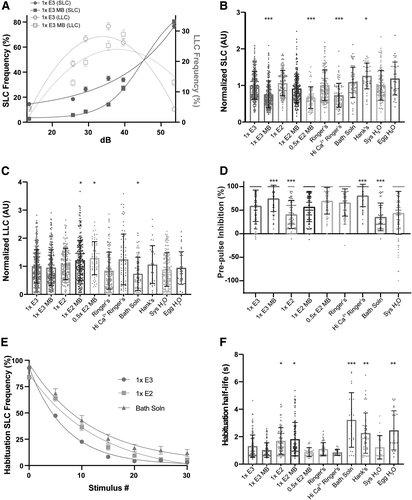Fig. 3 Embryo medium type impacts auditory-driven behaviors. (A) Acoustic startle responses, average SLC frequency (left y-axis), and LLC frequency (right y-axis) as acoustic stimulus intensity increases in 1 × E3 or 1 × E3 with methylene blue-treated larvae (mean ± SEM). (B) Normalized SLCs and (C) LLCs (AU), calculated by the area under the SLC or LLC frequency curves, respectively, for individual larvae, normalized to 1 × E3 (1 × E3: n = 397; 1 × E3 MB: n = 245; 1 × E2: n = 166; 1 × E2 MB: n = 231; 0.5 × E2 MB: n = 64; Ringer's: n = 141; Hi Ca2+ Ringer's: n = 79; Bath Solution: n = 61; Hank's: n = 36; Sys H2O: n = 123; Egg H2O: n = 36) (mean ± SD). (D) Rate of prepulse inhibition (1 × E3: n = 263; 1 × E3 MB: n = 118; 1 × E2: n = 108; 1 × E2 MB: n = 137; 0.5 × E2 MB: n = 63; Ringer's: n = 115; Hi Ca2+ Ringer's: n = 62; Bath Solution: n = 61; Sys H2O: n = 123) (mean ± SD). (E) Short-term habituation, average SLC frequency during 30 acoustic stimuli at highest intensity in 1 × E3-, 1 × E2-, and Bath Solution-treated larvae (mean ± SEM). (F) SLC half-life calculated by nonlinear regression (one-phase exponential decay) of SLC frequency curves for individual larvae. Asterisks represent statistical significance for medium type compared to 1 × E3 (mean ± SD, Wilcoxon/Kruskal–Wallis tests with Wilcoxon Each Pair for nonparametric multiple comparisons, *p < 0.01, **p < 0.001, ***p < 0.0001). AU, arbitrary unit.
Image
Figure Caption
Acknowledgments
This image is the copyrighted work of the attributed author or publisher, and
ZFIN has permission only to display this image to its users.
Additional permissions should be obtained from the applicable author or publisher of the image.
Full text @ Zebrafish

